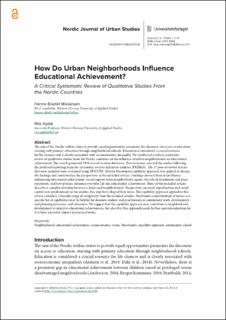| dc.contributor.author | Mikkelsen, Hanne Eikefet | |
| dc.contributor.author | Agdal, Rita | |
| dc.date.accessioned | 2024-04-10T06:31:27Z | |
| dc.date.available | 2024-04-10T06:31:27Z | |
| dc.date.created | 2024-03-04T22:03:25Z | |
| dc.date.issued | 2024 | |
| dc.identifier.citation | Nordic Journal of Urban Studies. 2024, 4 (1), 1-21. | en_US |
| dc.identifier.issn | 2703-8866 | |
| dc.identifier.uri | https://hdl.handle.net/11250/3125632 | |
| dc.description.abstract | The aim of the Nordic welfare states to provide equal opportunities permeates the discourse on access to education, starting with primary education through neighborhood schools. Education is considered a crucial resource for life chances and is closely associated with socioeconomic inequality. We conducted a critical systematic review of qualitative studies from the Nordic countries on the influence of urban neighborhoods on educational achievement. The search generated 7009 records in nine databases. Two reviewers selected the studies following the preferred reporting items for systematic reviews and meta-analyses (PRISMA). The 17 peer-reviewed articles that were included were evaluated using EPICURE. Martha Nussbaum’s capability approach was applied to discuss the findings and contextualize the perspectives in the included articles. Findings showed three main themes influencing educational achievement: social support from neighborhood agents, the role of attachment and place reputation, and how policies influence everyday life and educational achievement. Many of the included articles describe a complex interplay between schools and neighborhoods. Perspectives on social reproduction and social capital were predominant in the articles; this may have shaped their focus. The capability approach applied in this review considers a broader range of complexity than the included articles. Nussbaum’s concretization of justice as a specific list of capabilities may be helpful for decision-makers and practitioners in community work, development and planning processes, and education. We suggest that the capability approach may contribute to neighborhood development to improve educational achievements, but also that this approach needs further operationalization for it to have a positive impact in practical terms. | en_US |
| dc.language.iso | eng | en_US |
| dc.publisher | Universitetsforlaget | en_US |
| dc.rights | Navngivelse 4.0 Internasjonal | * |
| dc.rights.uri | http://creativecommons.org/licenses/by/4.0/deed.no | * |
| dc.title | How Do Urban Neighborhoods Influence Educational Achievement? A Critical Systematic Review of Qualitative Studies From the Nordic Countries | en_US |
| dc.type | Peer reviewed | en_US |
| dc.type | Journal article | en_US |
| dc.description.version | publishedVersion | en_US |
| dc.rights.holder | Copyright © 2024 Author(s) | en_US |
| dc.source.pagenumber | 1-21 | en_US |
| dc.source.volume | 4 | en_US |
| dc.source.journal | Nordic Journal of Urban Studies | en_US |
| dc.source.issue | 1 | en_US |
| dc.identifier.doi | 10.18261/njus.4.1.1 | |
| dc.identifier.cristin | 2251975 | |
| cristin.ispublished | true | |
| cristin.fulltext | original | |
| cristin.qualitycode | 1 | |

